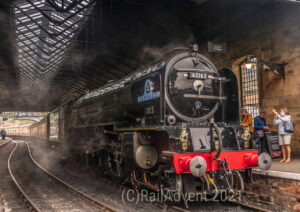The Lincolnshire Coast Light Railway (LCLR) is to renovate and move its Old Coal Office to its new South Loop terminus.
The wooden building dates back to around the turn of the nineteenth-to-twentieth century, and was built by the Great Northern Railway (GNR) at Skegness station.
In its new location, the Old Coal Office will operate as an interpretation centre at the new station, showcasing the history of the world’s first heritage railway to be built by enthusiasts.

It will also present the story of Ellis Bros (Contractors) Ltd., the company that owns the Water Leisure Park, Waterford and Greenacres holiday parks in the Skegness area. The company boast of its work over seven decades, including building modern housing and other amenities in Skegness, Wainfleet and district.
The Old Coal Office forms part of Skegness’s railway and industrial heritage. It was sold out of railway use in 1947 and moved to Ellis Brothers’ site in Lansdown Road, Skegness. It hosted the company’s offices until 2023.
The firm’s founder, the late Fred Ellis, took a keen interest in Lincolnshire‘s – and particularly Skegness’ – history and heritage, and wanted to conserve the building and make it available for public use.

The building has a clerestory roof, similar to those that Midland Railway, Great Western Railway and North Eastern Railway used on early railway carriages. However, GNR, which operated the line to Skegness until its amalgamation into the London & North Eastern Railway, did not use this roof style.
The explanation for this anomaly is not known, although one theory is that the roof was taken from an old carriage and added to the building to give more light to the people working in it. A 1907 photograph in Skegness Library shows what is thought to be the Coal Office, but without a clerestory.
The LCLR welcomes any information and background on the building and how the Great Northern handled coal traffic for the developing resort of Skegness.
Although it is in remarkably good condition, the building will be renovated for its new role, and is expected to be moved to South Loop during August, and to be ready for opening to the public next year. Work has been delayed and interrupted by the prolonged heavy rainfall which Lincolnshire has experienced since last autumn, which has affected the water table and the ability to move equipment and materials to the site. However, LCLR says that “good progress is now being made”.
East Lindsey District Council, South Holland District Council and Boston Borough Council have granted £24,250 to fund the project. These bodies administer the UK Shared Prosperity Fund (and Rural Prosperity Funding) in this area, a fund that until recently was known as the Levelling Up programme. Ellis Bros (Contractors) Ltd is contributing a further sum of £8,000, giving a total of £32,250 for the project.
LCLR, which last month ran a successful Diesel Day, believes that the new station and the interpretation centre will help to boost the economy of Skegness, and will encourage more people to explore the coast’s heritage.
The Railway runs along a route of around three-quarters of a mile. Details of its running days and ticket prices are available here on their website.

“We are delighted to be able to conserve for the future this remarkable survival of Skegness’ railway and industrial heritage, thanks to the contribution from the councils. As well as enabling us to show the contribution to the economy and infrastructure of Skegness, the new role for the Old Coal Office helps us ensure the long term future for the railway and to enhance the existing achievements of the volunteers’ work.
“This contribution from the UK Shared Prosperity Fund will enable Skegness to escape from the widely held perception that the town is some sort of ‘cultural vacuum’. Anything which does that by adding to the appeal of the heritage attractions of the Skegness district will benefit all of the town.
“Skegness, as we know it, was only brought about because of the railways – before they reached the area, Skegness was a fishing hamlet of just six houses. Everything we have is down to the railways and the LCLR contributes towards that heritage.”
Chief Executive Officer for Ellis Bros (Contractors) Ltd. and Company Secretary of the Lincolnshire Coast Light Railway, John Chappel
“Rebuilding of the Old Coal Office at our new station enables us to create a ‘destination’ at the end of our line and let people learn about its unique history and heritage – at the moment trains terminate beside Skegness Airfield, but passengers cannot disembark. The locomotive uncouples at South Loop from the carriages, runs round them and then re-attaches, to return to Walls Lane station.
“We are extremely grateful to the local authority. to the Government’s fund and especially to Ellis Bros. (Contractors) Ltd for making this possible.
“Some idea of the economic benefits the Lincolnshire Coast Light Railway brings to the area can be gauged from the distances people travel from to enjoy the railway and experience our unique collection of historic locomotives, carriages and wagons, many of which date from the First World War battlefields and even earlier.”
Chair of the Lincolnshire Coast Light Railway Historic Vehicles Trust, Richard Shepherd





Responses